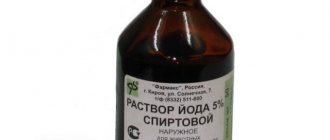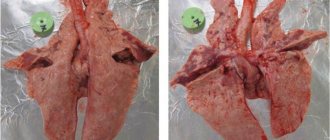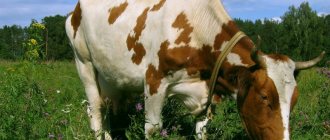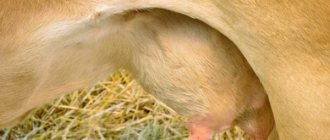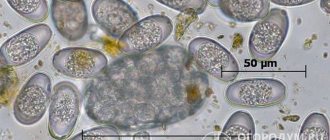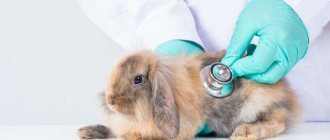Sources and routes of infection
An infection can enter a rabbit's body in different ways. Most often this happens:
- at birth (newborn animals become infected from the mother);
- through direct contact;
- by airborne droplets;
- through common water vessels and other care supplies.
Once bacteria enter the body, an asymptomatic infection appears in the upper respiratory tract. As the name suggests, owners do not notice any changes in the animal's behavior or any symptoms that may indicate illness. The disease becomes noticeable only when the resistance of the infected animal’s body to the virus decreases or is interrupted (during pregnancy, childbirth, lactation, excessive obesity of animals, stress and nutritional deficiency). The rabbit's genetic predisposition to the disease is also taken into account.
Rabbits can also be asymptomatic carriers as a result of contracting the infection.
Did you know? Rabbits are often mistakenly classified as rodents. However, this is a completely different family of mammals - hare.
A detailed overview of pasteurellosis
The causative agent of the infectious disease is the Pasteurella bacterium (Pasteurella multocida).
The rod may have an ovoid or slightly elongated shape. Despite its immobility and the impossibility of spore formation, it develops and reproduces well in a nutrient medium. However, it loses its stability when exposed to chemicals and external factors. Pasteurellas are preserved:
- in water and corpses up to 3 months;
- in manure up to 30 days;
- on galvanized mesh 23 days;
- on wooden surfaces about 56 days;
- in soil up to 72-84 hours;
- in direct sunlight for a few minutes.
At temperatures above 75˚C, microorganisms die instantly. Infected or recovered animals are carriers of harmful pathogens. The main route of infection in most cases is the respiratory tract. In addition, people can be carriers if there are dangerous bacteria on their clothes, shoes or equipment. Infection also occurs through feces, urine, poultry, dogs or other livestock. First of all, the bacteria affect weakened and young individuals. Therefore, when treating pasteurellosis in rabbits, the dosage and methods of taking medications must be taken into account.
All age categories and breeds of rabbits are susceptible to pasteurellosis. In addition, the infectious disease is not seasonal or territorial in nature, which is why the risk of an epidemic outbreak is very high.
Clinical signs
Pasteurellosis has two forms: acute and chronic. Each has its own symptoms, which, if detected, must be taken immediately.
Acute form
The acute form (or hemorrhagic sepsis) is caused by highly virulent strains. It occurs suddenly and is characterized by a rapid course and high mortality rate. The incubation period ranges from 5 to 12 hours.
The disease usually begins with:
- temperature rise to 39° and above;
- depression;
- depression;
- general weakness;
- lack of interest in food.
Find out why rabbits die for no apparent reason and what to do about it.
Then pus may begin to discharge from the nose, a runny nose, bronchitis, shortness of breath, and diarrhea may appear. In adult females, acute inflammation of the reproductive organs develops, which is accompanied by serous, mucous or mucopurulent outflow.
The acute form of pasteurellosis can last up to several days and usually ends in death.
Did you know? There are currently about 100 species of rabbits in the world.
Chronic
Animals that survive acute infection develop a chronic form of the disease. This is most common in individuals living in small groups. Rabbits that have been exposed to less virulent strains of infection (experiencing normal upper respiratory disease) become insensitive to highly virulent strains.
Signs:
- fibrillary bronchopneumonia;
- pericarditis;
- runny nose (initially serous, and later mucopulent);
- purulent conjunctivitis;
- dyspnea;
- diarrhea;
- depression;
- severe exhaustion;
- rapid weight loss;
- dull fur.
Abscesses form under the skin around the larynx and muscles and open after a few weeks. In addition, there is inflammation of the middle and inner ear, which is manifested by a yellowish-gray discharge from the ear canal. In females, chronic inflammation begins to develop in the organs of the reproductive system, which leads to decreased fertility, and in pregnant rabbits - to self-abortion and purulent mastitis.
In males, purulent inflammation of the testicles is observed, which causes infertility.
Most often, rabbits die after several weeks of illness, but sometimes with the help of medications their life can be extended to several months. Important! Pasteurellosis is dangerous for people, so if this infection is detected in a pet, it is imperative to undergo examination by a doctor.
Pathogen and modes of transmission
The causative agent of the pathology is a bacillus from the genus Pastuerella – Pastuerella multocida. This is a variable variety of pathogen, and it is difficult to determine the cause of origin.
Pasteurellosis is transmitted from sick animals or those who have recovered from this disease (Pasteurell carriers). Infection is mainly transmitted through the respiratory system.
The pathogen can develop if pets have reduced resistance in the body and at the same time increased virulence of pathogens that are at that moment in the respiratory system as saprophytes. Pasteurellosis develops and spreads faster if the pet’s body has reduced resistance, it receives inadequate food, or the conditions for keeping the animal are violated.
The disease can affect rabbits regardless of the season, age and breed. Young rabbits are more susceptible to pasteurellosis than older rabbits.
The infection can be transmitted not only from infected rabbits and other farm animals that are sick with pasteurellosis, but also from humans (through clothing and shoes), with contaminated food and care items. After entering the animal’s body, the rod multiplies quickly, after which it enters the lymph and blood, which causes septicemia. The influence of waste products of Pasteurella leads to damage to the vascular walls, due to which their permeability increases and hemorrhagic diathesis develops, and the subcutaneous cell tissue becomes edematous.
Pathological changes
Pasteurellosis leads to the following consequences:
- Severe hemorrhages on the mucous and serous membranes and in many internal organs.
- Inflammation of catarrhal or purulent mucous membranes of the nose and sinuses.
- The nasal mucosa is significantly swollen, sometimes covered with pinpoint ulcers.
- The lungs are enlarged, swollen, and bloodshot. They have numerous formations accompanied by pneumonia.
- There is a large amount of bleeding fluid in the trachea and chest cavity.
- Purulent tracheitis, serous fibrinous pneumonia, and pericarditis are observed.
- Necrotic foci and granulomas appear in the liver.
- Numerous abscesses form in the subcutaneous area, muscles, lungs, brain and middle ear.
- In females, purulent inflammation of the uterus and mammary gland is observed, while in males, purulent inflammation of the testicles is observed.
Important! Rabbits' ears are very sensitive and animals should never be caught by them.
Not to be confused with the viral twin
Pasteurella hemorrhagic septicemia of rabbits (microbial infection) and viral hemorrhagic disease of rabbits (viral infection) are different diseases.
Hemorrhage is a type of small internal bleeding
Although outwardly the signs of hemorrhages are very similar. A virus is tens or even hundreds of times smaller than a microbe. And the type of internal hemorrhages is different. With VGBK - dotted, with pasteurellosis - striped.
How to treat pasteurellosis in rabbits
Animals without clinical signs of infection and those in contact with sick rabbits should use immune serum - polysepsin. Infected individuals must be isolated immediately. Veterinarians typically prescribe treatment for 3 to 5 days with broad-spectrum antibiotics and sulfonamides. The effectiveness of treatment largely depends on the nutritional conditions and housing of the animals.
Unfortunately, treatment of individual infected individuals, in whom the disease primarily affects the upper respiratory tract, is not effective enough. Even transitional doses of antibiotics provide only a temporary positive effect. Sometimes they can only prevent complications of the disease process, but not cure it.
Treatment methods
The effectiveness of treatment for pasteurellosis largely depends on at what stage of the disease therapy is started. Therefore, if you notice the first signs of illness in one or more rabbits, you should immediately seek veterinary help.
First of all, rabbits with symptoms of the disease should be isolated from healthy relatives. They are given separate housing and equipment. The treatment regimen for different forms of pasteurellosis is different, but in both cases antibiotics are used. Of the antibacterial drugs, the most effective are Tetracycline or Biomycin, as well as Levomycetin and Oxytetracycline.
In addition to antibiotics, sulfonamides are prescribed for pasteurellosis - Norsulfazole, Sulfadimezin.
The treatment regimen, duration of treatment and dosage are determined by the veterinarian. In acute cases, therapy lasts 3-4 days. Medicines are administered intramuscularly 1-2 times a day. The prognosis for recovery is favorable only if treatment is started at an early stage, when irreversible damage to internal organs has not yet developed.
Treatment of the chronic form of pasteurellosis in rabbits is carried out according to a different scheme. In this case, sulfonamide drugs and antibiotics are used alternately:
- the first 3 days - injections of Norsulfazole or Sulfadimezine;
- the next 3 days - antibiotic injections;
- then treatment with sulfonamides is repeated for 3 days.
In addition, rabbits suffering from pasteurellosis are given a special serum that helps treat pigs. This therapy shows good results.
For conjunctivitis, antibacterial eye drops are prescribed. If necessary, wash out the lacrimal canals. Abscesses are treated surgically. Rabbits have very thick and viscous purulent discharge that forms hard plugs under the skin.
Often, surgical removal can be difficult if the abscess area is very large. Multiple surgeries may be required, as well as careful wound care.
The prognosis for chronic pasteurellosis is questionable. Due to severe exhaustion and intoxication, most rodents cannot cope with the infection. Plus, antibiotics put an additional burden on the body. On large farms, treating sick rabbits is considered inappropriate. The main task of the farm owner is to preserve as much of the livestock as possible. For this reason, all rabbits that have already developed symptoms of pasteurellosis are destroyed, and relatively healthy ones are urgently vaccinated.
Important! Meat and skins of dead rabbits cannot be used. They are burned or destroyed in biothermal pits.
After at least one case of pasteurellosis infection is confirmed on a farm, it is quarantined. One of the mandatory conditions for combating the disease is disinfection of the premises where animals are kept and the surrounding area.
Everything is subjected to treatment: floors, walls, cages, equipment, as well as work clothes and shoes that belong to farm workers. A rug is placed near the entrance to the room. It must be impregnated with one of the disinfectant solutions at a concentration of 2%:
- caustic soda;
- bleach.
Before disinfecting the rabbitry, mechanical cleaning of hard surfaces is performed. It is necessary to remove any remaining droppings, animal hair, leftover food, bedding, after moistening it all with a disinfectant solution. This will help destroy pathogenic bacteria in the biomaterial and prevent the spread of infection. Next, all garbage is burned.
Vaccine against pasteurellosis in rabbits
There are many vaccination options, one of them is the Pasorin-ol vaccine.
It is administered during the first 7 weeks of the animal, subcutaneously, in a dose of 1 ml, 0.5 ml on both sides of the neck. Animals weighing less than 1 kg should receive a dose reduced from 0.5 to 0.9 ml. In endangered environments, vaccination should be repeated after 2-3 weeks. Immunity occurs within 2 weeks after injection and lasts a maximum of 3 months. Immunity is largely due to proper nutrition and hygienic conditions. The vaccine should not be used in sick animals or in females 2 weeks before and 2 weeks after birth. A few hours after administration of the vaccine, an increase in body temperature of 0.5 to 1 °C may be observed. After some time, the temperature returns to normal without treatment. An inflammatory reaction may occur at the injection site, which quickly disappears.
Read more about the features of rabbit vaccination.
General preventive measures
In order to avoid contracting this infection in a rabbit, it is necessary to follow some preventive measures. Considering that this disease is characterized by a high mortality rate, the following recommendations can save not only the health, but also the life of the animal.
- Improving living conditions (controlling temperature fluctuations and maintaining proper humidity levels in the room).
- Carrying out periodic disinfection of premises and cages for rabbits using effective disinfectants.
- Mass vaccination.
Pasteurellosis is an infectious and highly contagious disease of rabbits. The disease is widespread on large rabbit farms, where it causes large losses. Treatment is rarely successful, so it is better to prevent the disease by adhering to preventive measures and using vaccinations.
What kind of disease is this and its causative agent?
Pasteurellosis is an infectious pathology that develops as a result of infection with bacterial microflora. The disease is typical for domestic rabbits and wild hares. The pathology occurs due to infection of animals by the bacterium Pasteurella multocida, which has a complex structure and often mutates. The latter makes the treatment of the disease difficult.
When infected, pets' nasal cavities, throat and trachea are affected. The disease develops against the background of a weakened immune system in rabbits, caused by non-compliance with living conditions (hypothermia, improper feeding, and so on). The pathology is dangerous because it causes death in 75% of cases.



